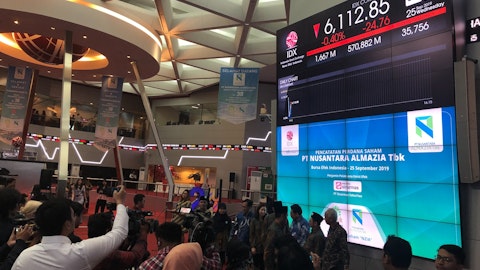If you look at your total margins and the return as a result, you actually see it favorably. Of course, naturally, this is a work in progress with customers, not everybody uses the right metric to make a purchasing decision. But definitely, there is remaining overhang in terms of some of the challenges from a financial-market perspective. And we’re making good progress with the types of customers that we are focusing on to be able to not only regain some of the market share but also diversify our customer base.
Margaret Kaczor: Okay. And that was in reference more to B2B domestic? Or is that both DTC and B2B domestic?
Nabil Shabshab: Thanks for the clarification. It’s B2B domestic. In DTC, in general, we have not seen an impact in terms of a price — a demand elasticity in terms of the pricing that we are at now. DTC seems to be stable.
Margaret Kaczor: Okay. Great. That’s helpful. And then as we think about B2B international, it seems like maybe that business, especially as we get into 2024 should maybe return to growth is the right way of phrasing it. How do you look at kind of tender contracts as best as you see them today as you go out into 2024? And kind of the market growth rate and your growth rate potentially, whether it’s ’24 or beyond?
Nabil Shabshab: Yes. So Margaret, let me start with the comment on the question on the tenders. So there has been a little bit of delays in Europe in general in terms of actually moving forward with tender decisions. We’re seeing some of it remain. We’re seeing some of it actually move forward. Fortunately, there is also a change in share in terms of the biggest customers that actually participate in those tenders. And they all happen to be our customers. So our focus is on continuing to work with all parties that provide them with the best value proposition and value. And then in some cases, we are sort of like gaining in one place and losing in another place, in general, within the same franchise of customers that we deal with. So the outlook for 2024 is a more stable market, and from what we can gather from the feedback of our distributors that we work with, and a little bit more return to the normal demand that we used to see before.
Operator: And the next question comes from the line of Robbie Marcus with JPMorgan.
Rohin Patel: This is actually Rohin on for Robbie. Just a couple of questions on our end. Just firstly, can you just walk through some of the puts and takes as you think about them for 2024, just between — and we touched on this, but just between some of the sales force attrition and DTC as well as the competitive pressures in the B2B business. Just to get a sense for how these are moderated and trending relative to one another. And then also just your views on the supply chain environment as you close out this year.
Nabil Shabshab: Okay. So let me start with the — in reverse order just quickly. From a supply chain environment, I think as we made the comments in our prepared remarks, we’re seeing that return to normal levels like before. We’re still working through some of the prepaid parts that we have on our balance sheet, and burning them down. As Mike said, we expect that to actually at a trickling rate, go out of — into the P&L by the middle of 2024. So in general, no major issues in supply chain. There are a few things here and there that remain as a lingering effect, but nothing that really is very concerning at this point in time. With respect to sales force attrition, I assume you’re referring to the DTC comments that we made about resizing the sales force.


